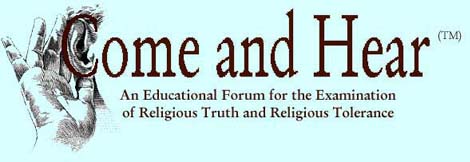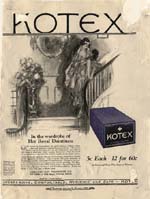
New America | ||||||||||||||||||||||||||||||||||||||||||||
 There are changes in the wind. Some people may be happy, some may be unhappy. Let's go directly to the Talmud to see its laws on some social concerns.

The notorious burqa, the head to toe face-and-body hiding gown of Afghanistan, has become a symbol of the oppression of women in Islam. 
A full-face burqa  Kotex Commercial, c. 1921(13) "In the wardrobe of Her Royal Daintiness …" With modern sanitary practices, products, and knowledge, it is difficult to understand how the laws of niddah would promote hygiene in the contemporary world. It is also hard to understand why those laws would be advocated in 1948 by Rabbi Dr. Epstein, or in 1999 by Rabbi Boteach. And given that many other cultures in the world thrived without the niddah laws, it is possible that those laws were not significantly hygienic, even in the days of the Talmud Sages. 
Rabbi Noson Gurary is an Orthodox and Hasidic rabbi. He is Executor Director of Chabad of Buffalo, New York, and is quoted by the Jerusalem Post, thus: "By demonstrating the philosophy of Jewish law and its moral values, we can bring a little beacon of light to this world."(6) 
You can help in the battle for Truth, Justice, and the American Way! Fight the forces of censorship and suppression of the Talmud, and bring about understanding between peoples of different faiths.  Rabbi Shmuel Kaplan officiates in a Chabad Lubavitch center in Potomac, Maryland, a prosperous suburb of Washington, DC. The center hosts a mitweh for Orthodox Jewish women to satisfy the niddah law. 
Violation of the Niddah Law, if deliberate, is punishable by death. 
Rabbi Dr. Isidore Epstein, editor of the Soncino Talmud, states that the law of Niddah promotes "respect for womanhood." Still, non-Jewish Americans may wonder how respect for womanhood is promoted by declaring a woman unclean for two weeks of every month, and teaching that she defiles everyone and everything she touches. We may respect things that defile, but is this the respect a woman would want? 
Rabbi Shmuley Boteach was a disciple of the late Rabbi Menachem Mendel Schneerson. He is (or was) friends with Uri Geller, Madonna, and Michael Jackson. 
Rabbi A. James Rudin, National Interreligious Affairs Director of The American Jewish Committee: 
Sigmund Freud, founder of psychoanalysis, at a psychoanalytic congress in The Hague, 1920 
Women in Burqas |
Niddah: A woman in the period of her menstruation.
— Soncino Talmud Glossary for the Babylonian Talmud
Non-Jewish Americans may find it difficult to comprehend the importance of menstruation in the Jewish religion and culture. One indication of its importance is that an entire tractate of the Babylonian Talmud, the Tractate Niddah, is devoted to menstruation laws. (17) We do not wish to subject the Talmud Sages to undue scrutiny. Many peoples, from the Australian Aborigines to the South African Bushmen, have put restrictions on menstruating women.(14) However, we in America are not being asked to move closer to the ways of the Australian Aborigines or South African Bushmen, but closer to the ways of the Talmud. Thus, it behooves us to look closely. Niddah in a NutshellThe Old Testament stipulates a woman is unclean during menstruation, but the Talmud stipulates her period of uncleanness lasts for an additional week after menstruation has ended. Niddah is the word used to denote the menstruating woman and her period of uncleanness. The niddah defiles everyone and everything she touches. She may not have sexual intercourse with her husband. If she does, he is subject to arrest and perhaps the death penalty. Some niddah laws apply to Gentile women, too. In his Introduction to Tractate Niddah, Rev. Dr. Israel W. Slotki states: Chapter IV is concerned with the condition of uncleanness of non-Jewish women, such as Samaritans, Sadduceans and idolaters … — Rev. Dr. Slotki(4) Thus it behooves all American men and women — Jew and Gentile alike — to come to grips with the laws of Niddah. Meet Typhoid MaryThe Jewish Encyclopedia gives an overview of the law of Niddah. It states that those laws are based on Leviticus 15:19, et seq. The Pentateuchal code (Lev. xv. 19 et seq.) ordains that a menstruous woman shall be unclean for seven days from the beginning of the period, whether it lasts only one day or all seven. — Jewish Encyclopedia(5) Let's look at the Bible verses cited by the Jewish Encyclopedia. Leviticus 15:19 reads:
— Leviticus 15:19 (KJV) So then, according to the Old Testament, a woman has to be isolated during her monthly period and she contaminates all who touch her. They also become "unclean."
— Leviticus 15:20-22 (KJV) Now the objects she touches become sources of uncleanness, and the contagion spreads. What happens if an "unclean" man touches other people or objects? Do they also become unclean? Leviticus does not tell us. But let us continue to read:
— Leviticus 15:23-28 (KJV) At the end of her period, the woman must give two pigeons and two turtles to the priest so he can slaughter them.
— Leviticus 15:29-30 (KJV) Talmud Laws "More Onerous"As if all of this were not sobering enough, the Jewish Encyclopedia informs us that the Talmud laws are even more onerous: In either case she is unclean for seven days only, but during this time her defilement is communicated to every object with which she comes in contact. These laws, however, have been extended in many ways and made more onerous, both by rabbinical traditions and interpretations and by customs which have been adopted by Jewish women themselves. According to these more rigid requirements, the woman must reckon seven days after the termination of the period. If, then, this lasts seven days, she can not become pure until the fifteenth day. Purification, furthermore, can be gained only by a ritual bath ("mitweh"); and until the woman has taken this she remains unclean according to the interpretation of R. Akiba (Shabbath 64b), which was accepted by the Rabbis generally. In addition to all this, a woman who does not menstruate regularly is unclean for a certain time before she becomes aware that the period has begun, and objects which she touches are defiled, since there is danger that the menses may have begun a short time before and that she may not have perceived the fact. — Jewish Encyclopedia(5) Notice in the above, "Jewish women themselves," are said to have introduced more onerous niddah laws. Soncino Translator, Rev. Dr. Israel Slotki, makes the same assertion in his Introduction to Tractate Niddah.(4) Neither cites a source for the assertion. This is a great loss. Why would Jewish women request the Sages to impose more restrictions on their lives? And why would the Sages encode those personal requests in a document that is said to be the Word of God?
Do your own Internet search on "Jewish ritual bath," "mikvah," "mikveh," "mitweh," "mikwa," etc. You will find many functioning mitwehs around the US, indicating the law of Niddah is very much alive today. A commercially available mitweh cosmetic bag is shown in the sidebar. (Note: In upcoming Talmud excerpts, we sometimes omit non-germane text and footnotes. Omission of text is indicated by an ellipsis (…). To see the full text and footnotes, follow the hot link at the end of the excerpt (see "Endnotes" for actual URL). It is our pleasure to make available on line a number of Talmud tractates, so that you can see the excerpt in full context. We indicate unprintable Hebrew characters, words, and phrases with the symbol [H].) Testing RagsBecause it is an offense to have marital relations during menstruation, and because a woman cannot know with certainty when menstruation has started, she must insert rags into her vagina before intercourse to test for menstrual fluids. MISHNAH. IT IS THE CUSTOM OF THE DAUGHTERS OF ISRAEL WHEN HAVING MARITAL INTERCOURSE TO USE TWO TESTING-RAGS, ONE FOR THE MAN AND THE OTHER FOR HERSELF, AND VIRTUOUS WOMEN PREPARE ALSO A THIRD RAG WHEREBY TO MAKE THEMSELVES FIT FOR MARITAL DUTY. IF A VESTIGE OF BLOOD IS FOUND ON HIS RAG THEY ARE BOTH UNCLEAN AND ARE ALSO UNDER THE OBLIGATION OF BRINGING A SACRIFICE. IF ANY BLOOD IS FOUND ON HER RAG IMMEDIATELY AFTER THEIR INTERCOURSE THEY ARE BOTH UNCLEAN AND ARE ALSO UNDER THE OBLIGATION OF BRINGING A SACRIFICE. IF, HOWEVER, … — Babylonian Talmud, Tractate Niddah 14a PunishmentNote in the above Mishnah, Niddah 14a, husband and wife are required to bring a sacrifice if they have intercourse during niddah. However, there is also provision to inflict the death penalty, presumably if the transgression was deliberate. MISHNAH. THERE ARE IN THE TORAH THIRTY-SIX [TRANSGRESSIONS WHICH ARE PUNISHABLE WITH] EXTINCTION: — Babylonian Talmud, Tractate Kerithoth 2b Don't Forget Depressions and FoldsBecause infractions of the Niddah laws can lead to consequences, a Jewish woman uses great care not to miss the onset of her menstruation. While using testing rags, she should push them into the depressions and folds of her vagina. GEMARA. … AND IF A WOMAN USES TESTING-RAGS WHEN SHE HAS MARITAL INTERCOURSE etc. Rab Judah citing Samuel ruled: A testing-rag used before marital intercourse does not reduce [the doubtful period of retrospective uncleanness] as an examination. What is the reason? — R. Kattina replied: Because the woman is in a hurry to do her marital duty. But what matters it even if she is in a hurry to do her marital duty? — Since she is in a hurry to do it she does not insert the testing-rag into depressions and folds. — Babylonian Talmud, Tractate Niddah 5a-5b You're under ArrestThe Sages arrested those who violated the niddah laws. The following account involves a woman who miscarried. The Sage Samuel examined the foetus and found it to be 41 days old. This enabled him to calculate that the couple had conceived the child during the woman's niddah period, and so the Sage had the husband arrested. GEMARA … But is it not a fact that when a certain sac was submitted to the Master Samuel he said, 'This is forty-one days old', but on calculating the time since the woman had gone to perform her ritual immersion until that day and finding that there were no more than forty days he declared, 'This man must have had marital intercourse during her menstrual period' and having been arrested he confessed? — Samuel was different from other people because his knowledge was exceptional. — Babylonian Talmud, Tractate Niddah 25b Somehow Samuel knew the date of the wife's last mitweh (as above, the ritual bath a woman takes on the completion of her menstruation) and compared that with the developed age of the foetus. How did the Sage know her last Mitweh was 40 days in the past? We are not told. Neighborhood WatchThe Jews of the Talmud report each other to the authorities for Niddah violations, or suspected Niddah violations. In the first excerpt from Tractate Kethuboth, we learn that a man is flogged because neighbors report he had sexual intercourse with his wife when she was niddah. GEMARA. … If a woman was known (10) among her neighbours to be a menstruant her husband (11) is flogged on her account for [having intercourse with] a menstruant. (12) — Babylonian Talmud, Tractate Kethuboth 72a Rev. Dr. Israel W. Slotki amplifies the text with footnotes:
— Rev. Dr. Slotki The reader might wonder how the neighbors know the wife is menstruating. Rev. Dr. Slotki refers us to Kiddushin 80a for an explanation (see his footnote 12). Here is the relevant passage from Kiddushin 80a: GEMARA. … For R. Hiyya b. Abba said in R. Johanan's name: We flagellate on the strength of presumption, we stone and burn on the strength if presumption, but we do not burn terumah on the strength of presumption. We flagellate on the strength of presumption, as Rab Judah. For Rab Judah said: If a woman is presumed a niddah by her neighbours, her husband is flagellated on her account as a niddah. (1) — Babylonian Talmud, Tractate Kiddushin 80a Kiddushin translator Rabbi Dr. H. Freedman amplifies the text with this footnote:
— Rabbi Dr. Freedman The answer is, then, that the neighbors are not certain the wife is menstruating: They presume she is, report the couple, and on the strength of this report, the husband is flogged. Rabbis Judge Vaginal DischargesFor most of us, the concept of our clergymen taking an interest in the color of our menstrual blood is foreign, but rabbis make rulings on the colors of menstrual blood: MISHNAH. FIVE KINDS OF BLOOD IN A WOMAN ARE UNCLEAN: RED, BLACK, A COLOUR LIKE BRIGHT CROCUS, OR LIKE EARTHY WATER OR LIKE DILUTED WINE. BETH SHAMMAI RULED: ALSO A COLOUR LIKE THAT OF FENUGREEK WATER OR THE JUICE OF ROASTED MEAT; BUT BETH HILLEL DECLARE THESE CLEAN. ONE THAT IS YELLOW, AKABIA B. MAHALALEL DECLARES UNCLEAN AND THE SAGES DECLARE CLEAN. R. MEIR SAID: EVEN IF IT DOES NOT CONVEY UNCLEANNESS AS A BLOODSTAIN IT CONVEYS UNCLEANNESS AS A LIQUID. R. JOSE RULED: IT DOES NEITHER THE ONE NOR THE OTHER. — Babylonian Talmud, Tractate Niddah 19a In the following incident, a Pharisee High Priest stops to talk to a Sadducee. By accident, some spittle from the Sadducee's mouth falls onto the High Priest. The High Priest is frightened that he had been defiled — perhaps the Sadducee has had sexual intercourse with his menstruous wife. On his return home, the High Priest's wife points out to him that the Sadducee wives shows their menstrual blood to the Pharisee Sages. GEMARA. … Our Rabbis taught: It once happened that a Sadducee was conversing with a High Priest in the market place when some spittle was squirted from his mouth and fell on the clothes of the High Priest. The face of the High Priest turned yellow and he hurried to his wife who assured him that although they were wives of Sadducees they paid homage to the Pharisees and showed their blood to the Sages. R. Jose observed: We know them better than anybody else [and can testify] that they show their menstrual blood to the Sages. There was only one exception, a woman who lived in our neighborhood who did not show her blood to the Sages but she died. — Babylonian Talmud, Tractate Niddah 33b The Sages also consider the possibility of menstrual blood found shortly after sexual intercourse, causing both spouses to be classified retroactively as unclean. They also consider blood on the testing-rag that might the result of a louse bite or a louse crushed by the husband's penis ("attendant") during sexual intercourse. This passage (from Niddah 14a) is attached in the Appendix: Niddah 14a Excerpt. Menstruation Frightens SnakesTalmud passages suggest that the rabbinic horror of menstrual fluids is not merely religious, but genuine and visceral. For example, in the following from the Tractate Shabbath, the possibility is considered of a woman attempting to drive away a snake. The ultimate weapon, according to the Sages, is for the woman to tell the snake, "I am menstruous." (Note that in the following, the translator uses the word "cohabit" to denote sexual intercourse.[15]) GEMARA. … If a woman sees a snake and does not know whether it has turned its attention to her or not, let her remove her garments and throw them in front of it; if it winds itself around them, its mind is upon her; if not, its mind is not upon her. What can she do? She should cohabit [with her husband] in front of it. Others say, That will even strengthen its instincts. Rather she should take some of her hair and nails and throw them at it and say, 'I am menstruous'. — Babylonian Talmud, Tractate Shabbath 110a Attributing their own attitudes to the snake, the rabbis believe it would be repulsed by a niddah. But what threat does the snake offer the woman? Of course, a venomous snake might bite the woman, but the rabbis' explanation continues in the following paragraph. GEMARA. … If a snake enters a woman, let her spread her legs and place them on two barrels; fat meat must be brought and cast on the burning coals; a basket of cress must be brought together with fragrant wine and placed there, and be well beaten together. They should take a pair of tongs in their hand, for when it smells the fragrance it will come out, so that it can be seized and burnt in the fire, as otherwise it will re-enter. — Babylonian Talmud, Tractate Shabbath 110a The danger, apparently, is that the snake will crawl up the woman's vagina and take up lodging. Jung once wrote that "a full understanding of the Jewish origins of psychoanalysis would carry us beyond Jewish Orthodoxy into the subterranean workings of Hasidism and then into the intricacies of the Kabbalah which still remain unexplored psychologically." For more discussion and references on Freud's doctrines and their relation to Orthodox Judaism, see http://www.newkabbalah.com/Jung3.html cached at http://www.come-and-hear.com/editor/freuds-gold-mine How to Explain?Rabbi Dr. Epstein, editor of the Soncino Talmud, offers two theories for these interesting laws. The first is the hygiene theory: Graver in its consequence and in full force to the present day is the law of Niddah. The reasons for the Niddah ordinances are many and varied. They promote sexual hygiene, physical health, marital continence, respect for womanhood, consecration of married life, and family happiness. — Rabbi Dr. Epstein(2) Rabbi Dr. Epstein wrote those words in 1947. Note that he says, "… in full force to the present day is the law of Niddah." Practical Social Explanation of the Niddah LawsLet us consider Rabbi Dr. Epstein's points. Hygiene: Menstruation is not a communicable disease. No one in medical history has been infected with it by contact with a carrier. Menstrual discharges are far less septic than excretory discharges, but we do not have entire tractates devoted to urination and defecation. Commercial sanitary napkins have been available since the 1920's. The Kimberly-Clark Corporation's web exhibit displays some early vintage ads for Kotex.(3) By that time, of course, many women of the industrialized world lived with indoor running water. Western literature indicates that maintaining feminine daintiness during menstruation has never been an overwhelming cultural problem. Marital Continence: Recall Rabbi Dr. Epstein states that "Niddah ordinances … promote … marital continence" as though it were a virtue, but does not explain why abstaining from sexual relations in married life is virtuous or desirable. Respect for Womanhood: Rabbi Dr. Epstein states that "Niddah ordinances … promote … respect for womanhood." Recall that according to the niddah laws, the woman is unclean for about two weeks of every month, and during that time she contaminates — defiles — everyone and everything she touches. Under ordinary circumstances, we would expect that would be a little hard on the self-esteem. But Rabbi Dr. Epstein does not explain how this degrading designation could promote respect for womanhood and we are left puzzled. Religious Explanation of Niddah LawsNow Rabbi Dr. Epstein gives another reason why niddah laws are seemly. But over and above these weighty reasons, they concern the very being of the soul of the Jew. They safeguard the purity of the Jewish soul, without which no true religious moral and spiritual life — individual or corporate — as Judaism conceives it, is attainable. — Rabbi Epstein(2) To most Americans, it seems extraordinary that menstruation could affect the soul of an entire people; menstruation is simply a fact of biology, much as saliva is a fact of biology. Just prior to making the above statement, Rabbi Dr. Epstein elucidates his reasoning. Here are the major points, but it behooves the reader to study the original text. [Concerning Jewish religious teachers,] fundamental to their view of life is the close relationship of body and soul, so that what affects the one affects the other … From this conception it follows that the soul is affected by the uncleanness of the body … In general, bodily uncleanness has a contaminating influence on the soul, disqualifying the person thus affected from approaching the sanctuary of God. — Rabbi Epstein(2) Rabbi Dr. Epstein offers us a tautology: the menstruating woman is "unclean" because LORD God (who created menstruation) considers menstruation unclean, and doesn't want a niddah around His sanctuary. But even so, we can all agree that the Bill of Rights of the United States of America guarantees the freedom of religion. Every religion embraces beliefs that seem strange or even bizarre to those outside the circle of believers. Judaism, too, has its unique aspects. Let us put into practice the ideal of the Chief Rabbi of the British Commonwealth, Rabbi Professor Jonathan Sacks: Let us be open-minded and learn about each others' religions. (See What We're About.) After all, the menstruation laws are just a Jewish thing, right? But wait. There is a reason we should all take this personally. It is possible that those laws may be applied to all Americans in the near future.
America Is Rapidly Becoming Talmudized
In 1991, the US Congress declared the Talmudic Noahide Laws to be the basis "upon which our great Nation was founded" (see America's New Government Church). Under Noahide Law regulations, idolaters (which includes Christians by definition) are put to death. Happy-Face CampaignThere is a campaign afoot to put a happy face on the law of Niddah and promote it to non-Talmudic women. Rabbi Shmuley Boteach, an Orthodox Hasidic and disciple of the late Rabbi Menachem Mendel Schneerson, the "Rebbe" of Chabad Lubavatich — is such a promoter. In his book, Kosher Sex, Rabbi Boteach speaks glowingly of the Talmudic prohibition of married sex for two weeks every month. He states that the Bible did mankind a favor by inventing a way to improve a marriage. For two weeks, the couple avoids "monotony" in their marriage by observing abstinence. Rabbi Boteach omits the harsh rhetoric of a woman's "uncleanness" and her defilement of "every object with which she comes in contact;" he omits mention of the testing rags pushed into the vagina; and he omits the rabbinical judgment about the colors of menstrual blood. He also omits mention of possible arrest and death penalty for violation — surely something that would spice up anyone's sex life. Instead, Rabbi Boteach tells his readers: While husband and wife are permitted to indulge in sex for two weeks, they will forge deep emotional bonds. They unite physically and feel close emotionally. Their passionate physical life deepens their emotion and feeling for each other. — Rabbi Boteach(8) In another of Rabbi Boteach's books, Judaism for Everyone, Rabbi Boteach writes: [This book] is my attempt to offer traditional Judaism to a modern Jewish and non-Jewish audience in a rational, intelligible, and inspiring light. — Rabbi Boteach(9) What a pity Rabbi Boteach gives such scanty information about the niddah laws. His treatment of the Niddah laws does not meet The Rudin Standard.(10) Perhaps Rabbi Boteach is concerned that a non-Orthodox readership would be uncomfortable with the nitty gritty of niddah. On the other hand, how can we ever achieve understanding between people of different faiths if we are not open and trusting with each other? Niddah and Blood RitualIn Animal Sacrifice and the Third Temple, we learned that after Temple priests kill the sacrificial animal, the priests dismember it, drain the blood, and dip their fingers in the blood to smear and sprinkle it around the Temple. The priests squeeze the blood out of the animal's heart, wash the stomach and other organs, and wash the entrails three times. Specially built channels that look like "nostrils" drain the blood into nearby streams. The Temple, then, and the priests are awash with the blood of slaughter and death. In Circumcision, we learned that the man who performs the ritual sucks the blood of the infant's bleeding penis with his mouth. That ritual, called mezizah, is practiced today, despite the knowledge of Jewish leadership that it can and has spread fatal diseases. But the blood of menses, which is passed without death, infliction of pain, or mutilation, causes revulsion and restriction. Visible and Invisible BurqasThe notorious burqa, the head to toe face-and-body hiding gown of Afghanistan, has become a symbol of the suppression of women in Islam. Let us review the Talmud law of Niddah: a woman is unclean for two weeks out of four, contaminating everything and everyone she touches, forbidden to her husband. When not menstruating, she is using testing rags. If she and her husband violate the law, they are subject to arrest and punishment. When menstruation is complete, she must take a ritual bath. If a woman took the Talmudic laws of menstruation seriously, it would be impossible for her to have a career. A menstruating female doctor would contaminate every patient and every instrument she touched; a menstruating lawyer would contaminate everything she handled in her law office: every chair, desk, telephone, law book, or computer keyboard. Some Muslim women wear cloth burqas, but not all burqas are made of cloth. Given the Niddah restrictions and regulations in the Talmud, it is only reasonable for American men and women to ask: Do we want to go there? Come and HearThere are 509 pages in Tractate Niddah.(18) Read the laws of niddah in context, and research your own topics of interest by using the Come and Hear™ Search Engine.
Thank you for your consideration of the above,
NEXT: New America 4: Jewish Harems in Talmud Law
Endnotes:
Appendix: Niddah 14a ExcerptHere is a significant excerpt from Tractate Niddah 14a. To see footnotes, follow the link at the end of the excerpt (to http://www.come-and-hear.com/niddah/niddah/niddah_14.html): MISHNAH. IT IS THE CUSTOM OF THE DAUGHTERS OF ISRAEL WHEN HAVING MARITAL INTERCOURSE TO USE TWO TESTING-RAGS, ONE FOR THE MAN AND THE OTHER FOR HERSELF, AND VIRTUOUS WOMEN PREPARE ALSO A THIRD RAG WHEREBY TO MAKE THEMSELVES FIT FOR MARITAL DUTY. IF A VESTIGE OF BLOOD IS FOUND ON HIS RAG THEY ARE BOTH UNCLEAN AND ARE ALSO UNDER THE OBLIGATION OF BRINGING A SACRIFICE. IF ANY BLOOD IS FOUND ON HER RAG IMMEDIATELY AFTER THEIR INTERCOURSE THEY ARE BOTH UNCLEAN AND ARE ALSO UNDER THE OBLIGATION OF BRINGING A SACRIFICE. IF, HOWEVER, ANY BLOOD IS FOUND ON HER RAG AFTER A TIME THEY ARE UNCLEAN BY REASON OF DOUBT BUT EXEMPT FROM THE SACRIFICE. WHAT IS MEANT BY 'AFTER A TIME'? WITHIN AN INTERVAL IN WHICH SHE CAN DESCEND FROM THE BED AND WASH HER FACE. BUT [IF BLOOD WAS FOUND SOME TIME] AFTER SUCH AN INTERVAL SHE CAUSES UNCLEANNESS RETROSPECTIVELY FOR A PERIOD OF TWENTY-FOUR HOURS BUT SHE DOES NOT CAUSE THE MAN WHO HAD INTERCOURSE WITH HER TO BE UNCLEAN. R. AKIBA RULED: SHE ALSO CAUSES THE MAN WHO HAD INTERCOURSE WITH HER TO BE UNCLEAN. THE SAGES, HOWEVER, AGREE WITH R. AKIBA THAT ONE WHO OBSERVED A BLOODSTAIN CONVEYS UNCLEANNESS TO THE MAN WHO HAD INTERCOURSE WITH HER. — Babylonian Talmud, Tractate Niddah 14a | |||||||||||||||||||||||||||||||||||||||||||
Footnotes:
Full specifics for each of the printed sources are provided in the Bibliography. Outside URLs were valid at the time this article was written. However, be mindful that URLs do change.
- Babylonian Talmud, "Introduction," Seder Tohoroth, Vol. I page xx available at http://www.come-and-hear.com/talmud/tohoroth.html#xx
- Ibid, page xxii available at http://www.come-and-hear.com/talmud/tohoroth.html#xxii
- Image from Tampax Pearl Plastic: www.tampaxpearl.com/pgirl_trend_ques.shtml . See also http://www.kimberly-clark.com/aboutus/ko_1930s.asp for a history of images in sanitary napkins
- Babylonian Talmud, "Introduction," Tractate Niddah, page xxvii, available at http://www.come-and-hear.com/niddah/niddah_0.html#xxvii
- Wilhelm Bacher and Jacob Zallel Lauterbach, writing for The Jewish Encyclopedia, s.v. "Niddah," Vol. IX, page 301, available at http://www.jewishencyclopedia.com/view_page.jsp?artid=276&letter=N
- "Jewish law institute launched in DC," Jerusalem Post, November 9, 2002, http://www.jpost.com/servlet/Satellite?pagename=JPost/A/JPArticle/ShowFull&cid=1036830287246, now moved to http://pqasb.pqarchiver.com/jpost/index.html?ts=1042784008 cached at: http://www.come-and-hear.com/editor/cp-jp-11-09-2002
Also: "Jewish Law Comes to D.C.," The Jewish Week, January 8, 2003, http://www.thejewishweek.com/news/newscontent.php3?artid=7074 cached as http://www.come-and-hear.com/editor/cp-jw-01-08-03 - Full text of that Mishnah is also available at http://www.come-and-hear.com/editor/capunish_2.html#36-extinctions
- Kosher Sex, pages 76, 77
- Judaism for Everyone, page ix
- "… one thing is clear. Partial, incomplete or pre-selected archival records will not be enough in a world where transparency and full disclosure is now the norm if an institution — whether political, financial, or spiritual — is to maintain its integrity." — "While the Messiah Tarries," Forward, Rabbi A. James Rudin, February 22, 2002: http://www.forward.com/issues/2002/02.02.22/oped2.html cached at: http://www.come-and-hear.com/editor/forward
- Image: "Freud at a psychoanalytic congress in The Hague, 1920," from Sigmund Freud: conflict & and Culture, Library of Congress, http://www.loc.gov/exhibits/freud/freud03.html
- "This Is Gold: Freud, Psychotherapy and the Lurianic Kabbalah," Sanford L. Drob, Ph.D., New Kabbalah http://www.newkabbalah.com/KabPsych.html cached at http://www.come-and-hear.com/editor/freud-with-zohar
- Historic Advertising, Kimberly-Clark Corporation, http://www.kimberly-clark.com/aboutus/ko_1920s.asp
- The Golden Bough, pages 699-700
- In the United States, cohabitation means only "living together" or "living together in an assumed sexual relationship outside marriage."
- Mikvah Ateres Yisroel http://www.his.com/~chabad/Mikvah.htm cached at http://www.come-and-hear.com/editor/mikveh-potomac
- Jews often call the Talmud "the Torah." According to many rabbinical experts, the Talmud is the Word of God, the basic book of Jewish law, and the foundation of Jewish culture. See What Come-and-Hear™ Is About, Critical Words of Talmud Study, and More Critical Words of Talmud Study at http://www.come-and-hear.com/editor/about.html http://www.come-and-hear.com/editor/critwords_1.html and http://www.come-and-hear.com/editor/critwords_2.html respectively.
- The Soncino translation of the Babylonian Talmud tractate Niddah is available in full at http://www.come-and-hear.com/niddah
- The Interpretation of Dreams by Sigmund Freud, A. A. Brill (Translator), Chapter 6E, available at http://www.spiritcommunity.com/dreams/dreambook5.html cached at http://www.come-and-hear.com/editor/freud-dream-work
- "Fromm, Freud, and Midrash," by Elliot B. Gertel, American Jewish Congress, Fall, 1999, page 1, (quoting Yasef Haim Yerushalmi, Freud's Moses: Judaism Terminable and Interminable, New Haven/ London: Yale University Press, 1991), page 99 http://www.findarticles.com/cf_0/m0411/4_48/59120278/p1/article.jhtml cached at http://www.come-and-hear.com/editor/ajc-freud-gertel
- Jung, C.G. (1975) Letters, Vol II. ed. by Gerhard Adler, Aniella Jaffe and R.F.S. Hull. Princeton, NJ: Princeton University Press. — as quoted by Sanford L. Drob, Ph.D, "The Lurianic Kabbalah: An Archetypal Interpretation," http://www.newkabbalah.com/Jung3.html cached at http://www.come-and-hear.com/editor/freuds-gold-mine
© Copyright Carol A. Valentine, 2003. See copyright statement at http://www.come-and-hear.com/copyright.html
NEXT: New America 4: Jewish Harems in Talmud Law
| Navigate This Site | |
 | |
| Home | |
| Valentine | |
| Dilling | |
| Talmud | |
| The Rabbis | |
| Supplement | |
| Glossary | |
| Download | |
| Admin | |
| | |
 Genuine Come and Hear™ CDs do not contain executable programs. When making CDs, do not include any files that end in .exe, .com, .bat, .vbs, .doc, .pif, .sit, or .scr. The person receiving the CD should use his own browser to view the files. This helps to protect him from harmful programs and viruses.
Genuine Come and Hear™ CDs do not contain executable programs. When making CDs, do not include any files that end in .exe, .com, .bat, .vbs, .doc, .pif, .sit, or .scr. The person receiving the CD should use his own browser to view the files. This helps to protect him from harmful programs and viruses. 





